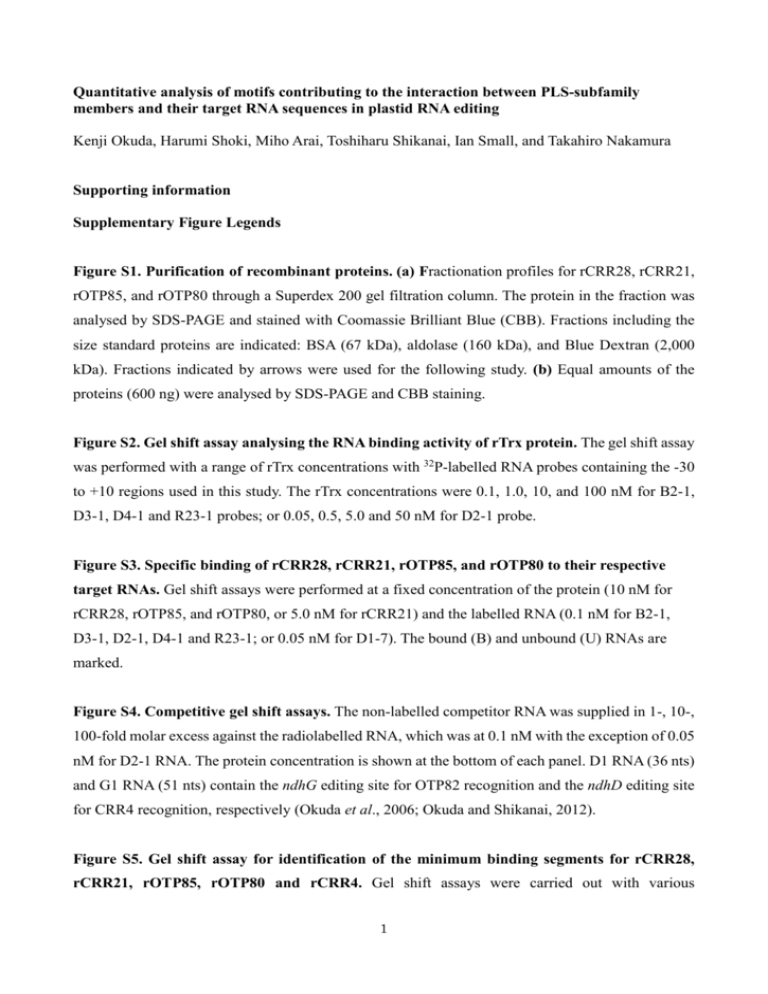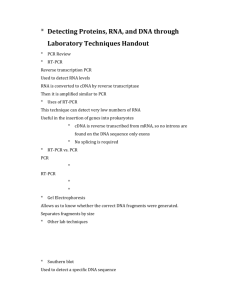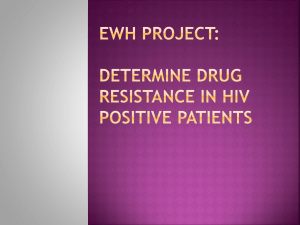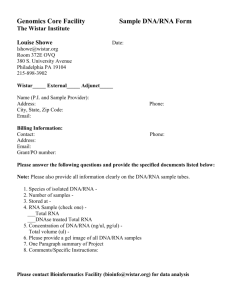tpj12687-sup-0010-Legend
advertisement

Quantitative analysis of motifs contributing to the interaction between PLS-subfamily members and their target RNA sequences in plastid RNA editing Kenji Okuda, Harumi Shoki, Miho Arai, Toshiharu Shikanai, Ian Small, and Takahiro Nakamura Supporting information Supplementary Figure Legends Figure S1. Purification of recombinant proteins. (a) Fractionation profiles for rCRR28, rCRR21, rOTP85, and rOTP80 through a Superdex 200 gel filtration column. The protein in the fraction was analysed by SDS-PAGE and stained with Coomassie Brilliant Blue (CBB). Fractions including the size standard proteins are indicated: BSA (67 kDa), aldolase (160 kDa), and Blue Dextran (2,000 kDa). Fractions indicated by arrows were used for the following study. (b) Equal amounts of the proteins (600 ng) were analysed by SDS-PAGE and CBB staining. Figure S2. Gel shift assay analysing the RNA binding activity of rTrx protein. The gel shift assay was performed with a range of rTrx concentrations with 32P-labelled RNA probes containing the -30 to +10 regions used in this study. The rTrx concentrations were 0.1, 1.0, 10, and 100 nM for B2-1, D3-1, D4-1 and R23-1 probes; or 0.05, 0.5, 5.0 and 50 nM for D2-1 probe. Figure S3. Specific binding of rCRR28, rCRR21, rOTP85, and rOTP80 to their respective target RNAs. Gel shift assays were performed at a fixed concentration of the protein (10 nM for rCRR28, rOTP85, and rOTP80, or 5.0 nM for rCRR21) and the labelled RNA (0.1 nM for B2-1, D3-1, D2-1, D4-1 and R23-1; or 0.05 nM for D1-7). The bound (B) and unbound (U) RNAs are marked. Figure S4. Competitive gel shift assays. The non-labelled competitor RNA was supplied in 1-, 10-, 100-fold molar excess against the radiolabelled RNA, which was at 0.1 nM with the exception of 0.05 nM for D2-1 RNA. The protein concentration is shown at the bottom of each panel. D1 RNA (36 nts) and G1 RNA (51 nts) contain the ndhG editing site for OTP82 recognition and the ndhD editing site for CRR4 recognition, respectively (Okuda et al., 2006; Okuda and Shikanai, 2012). Figure S5. Gel shift assay for identification of the minimum binding segments for rCRR28, rCRR21, rOTP85, rOTP80 and rCRR4. Gel shift assays were carried out with various 1 concentrations of the protein and a fixed concentration of the 32 P-labelled RNA probe. The RNA probe used was at 0.1 nM with the exception of 0.05 nM for D2-1 RNA. The protein concentrations were as follows: 0.1, 1.0, 3.0, 5.6, 10, 17.5, 30, 56, and 100 nM for rCRR28; 0.05, 0.1, 0.175, 0.3, 0.56, 1.0, 3.0, 10, and 30 nM for rCRR21; and 0.1, 0.3, 0.56, 1.0, 1.75, 3.0, 10, 17.5, and 30 nM for OTP85, OTP80 and rCRR4. The results are summarised in Figures 2 and 3. Figure S6. Preparation of truncated rOTP85 and rCRR28 proteins and their RNA binding activities. (a) Domain organisations of rOTP85ΔDYW, rCRR28ΔDYW, rDYW(OTP85), and rDYW(CRR28). PPR (P, L, and S), E, and DYW motifs are shown. The thioredoxin domain and V5-Hisx6 epitope derived from the expression vector are shown as hashed boxes. (b) Profile of rOTP85ΔDYW and rCRR28ΔDYW in the gel filtration column. (c) Equal amounts (600 ng) of the purified proteins were analysed by SDS-PAGE and CBB staining. (d) Gel shift assays were performed with a range of concentrations (0.1, 0.3, 0.56, 1.0, 1.75, 3.0, 10, 17.5, 30 nM) for rOTP85ΔDYW and rCRR28ΔDYW with labelled RNA as indicated. Bound (B) and (U) unbound RNAs are marked. Figure S7. Preparation of rCRR21 lacking C-terminal L2, S and E motifs, and its RNA binding activity. (a) Domain organisation of rCRR21ΔL2SE. PPR motifs (P, L, and S) are shown. The thioredoxin domain and V5-Hisx6 epitope derived from the expression vector are shown as hashed boxes. The gel filtration profile and the CBB profile of the purified protein are shown in (b) and (c), respectively. (d) The gel shift assay was carried out under the same conditions as for rCRR21 (0.05, 0.1, 0.175, 0.3, 0.56, 1.0, 3.0, 10, 30 nM of the protein; 0.05 nM of the D2-2 RNA probe). Figure S8. Preparation of amino acid substituted CRR21. (a) Domain organisation of the amino acid substituted CRR21, named as rCRR21var (P3T6D1′). PPR (P, L, and S) and E motifs are shown. The thioredoxin domain and V5-Hisx6 epitope derived from the expression vector are shown as hashed boxes. Residue 6 of the 18th PPR motif was substituted from Asn (N) to Thr (T). The gel filtration profile and the CBB profile of the purified protein are shown in (b) and (c), respectively. 2 Supplemental methods Site-directed mutagenesis of rCRR21 Site-directed mutagenesis was performed with a QuickChange II site-directed mutagenesis kit (Stratagene) by PCR with a pair of complementary oligonucleotides of 43 bases (GCATACGCCCGAGATCATGGCAGTGGAGAGAGGCAACTCGCTG) that contained a mutation of the 18th P motif (P3N6D1′) to (P3T6D1′) and with the rCRR21/pBAD/Thio-TOPO as a template. Parental DNA was digested with DpnI to remove the methylated strands. The synthesized plasmid DNA was used to transform E. coli XL1-Blue. Expression and purification of rCRR28ΔDYW, rOTP85ΔDYW, rDYW(CRR28), rDYW(OTP85), rCRR21ΔL2SE, and rCRR21var(P3T6D1′) DNA fragments encoding truncated CRR28 and OTP85 lacking their DYW motifs, the DYW motifs of CRR28 and OTP85, and truncated CRR21 lacking its C-terminal L2 and S motifs were amplified from genomic DNA by PCR using the primers rCRR28-FW (5′-TCCACCGCCGGTAACCAT-3′) and rCRR28ΔDYW-RV (5′-CTGTTGGTATATCTGTTTGG-3′), rOTP85-FW(5′-TGCAATTCTCTAAGAGAGC-3′) and rOTP85ΔDYW-RV (5′-TTTAGCTCTTTCACCATTTC-3′), rDYW(CRR28)-FW (5′-TTGAAGGTGATCGACGACA-3′) and rCRR28-RV(5′- CAGTAGTCTAAACAAGAGCA-3′), rDYW(OTP85)-FW (5′-GCTTTCAGGTTATGTTCCTG-3′) and rOTP85-RV (5′CCAAAAATCCCCACAAG-3′), and rCRR21-FW (5′- CATTTCTCCTTCTTCCACATC -3′) and rCRR21ΔL2SE-RV (5′-TCTGATGTTGTCTGGTTTAAG-3′), respectively. These fragments were cloned in-frame into pBAD/Thio-TOPO vector (Invitrogen). rCRR28ΔDYW, rOTP85ΔDYW, rDYW(CRR28), rDYW(OTP85), rCRR21ΔL2SE, and rCRR21var(P3T6D1′) were expressed in Escherichia coli LMG194 as fusion proteins with thioredoxin at the N-terminus and V5 and Hisx6 epitope tags at the C-terminus. Escherichia coli cultures were grown at 28 oC [30oC for rDYW(CRR28) and rDYW(OTP85), 25 oC for rCRR28ΔDYW] in LB medium with carbenicillin to an OD650 of 0.45 and cooled on ice for 20 min. Protein expression was induced by the addition of 0.02% arabinose[ 0.5% arabinose for rDYW(CRR28) and rDYW(OTP85); 0.01% arabinose for rCRR28ΔDYW], and cultures were incubated for 6 h at 18 oC[ 4h at 30oC for rDYW(CRR28) and rDYW(OTP85); 9h at 15oC for rCRR28ΔDYW ]. Harvested cells were suspended in cold lysis buffer (50 mM Tris-HCl [pH 7.5], 0.3 M NaCl, 7 mM β–mercaptoethanol, 1 mM 3 phenylmethylsulfonyl fluoride, and 0.01% CHAPS). Cells were lysed at 4 oC by sonication, cooled on ice for 5 min, and sonicated six times. The lysate was cleared by centrifugation at 15,000 g for 30 min. The following steps were performed at 4oC. The All six proteins were purified by binding to Ni-NTA agarose (Qiagen). To remove particulates, the rCRR28ΔDYW, rOTP85ΔDYW, rCRR21ΔL2SE, and rCRR21var(P3T6D1′) were resolved on a Superdex 200 column (GE Healthcare) in buffer E (20 mM HEPES-KOH [pH 7.9], 60 mM KCl, 12.5 mM MgCl2, 0.1 mM EDTA, 17% glycerol, and 2 mM dithiothreitol). The fractionated rCRR28ΔDYW, rOTP85ΔDYW, rCRR21ΔL2SE, rCRR21var(P3T6D1′), rDYW(CRR28), and rDYW(OTP85) were concentrated with a centrifugal concentrator and dialyzed in buffer E. The proteins were stored in aliquots at -80oC. The protein concentration was determined by using the method of Bradford. Bovine serum albumin was used as the standard. 4







